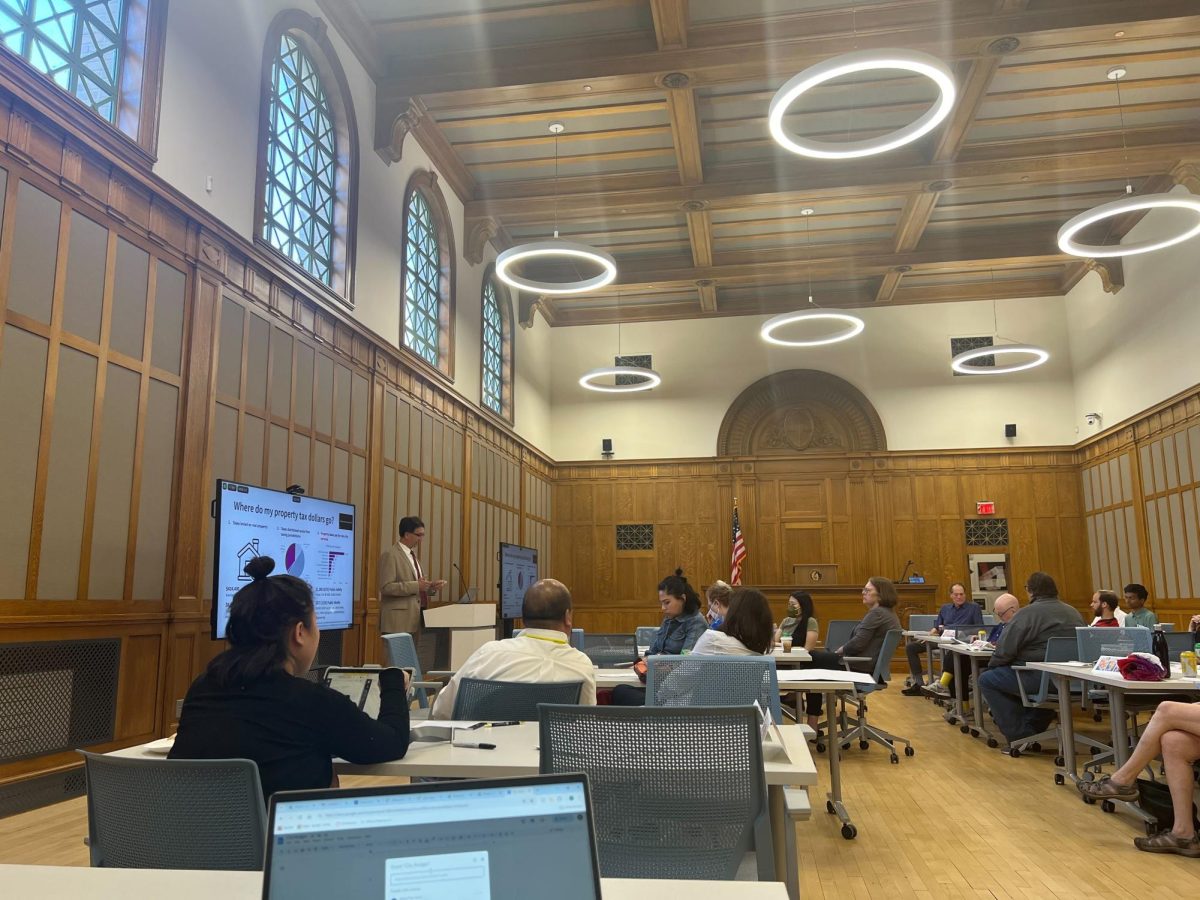Every Monday night, The Badger Herald gets a call from Capital Newspapers confirming the Herald’s issue will be on the stands the next morning.
Operating at 40,000 to 60,000 papers per hour, it only takes the company’s three-story metro press machine 10 to 20 minutes to print the Herald’s 10,000 print circulation.
The 21 hours between 9 a.m. to 6 a.m. the next day are spent printing, packaging and delivering publications for Madison readers, Diane O’Dair, Capital Newspapers prepress coordinator, said.
“It’s amazing to see something this big move in unison,” O’Dair said.

Behind-the-scenes
Capital Newspapers’ press prints five daily newspapers, five or six twice-a-week newspapers and two or three weekly newspapers, not including commercial pamphlets, O’Dair said.
The hissing, beeping and ringing of the press fills the room, shaking the concrete ground. Perspiring workers stand at conveyer belts, inserting ads, sorting page templates and monitoring the press.
Without the cooling system to maintain a temperature of 65 degrees in the pressroom, the operating machinery would quickly push the temperature to triple-digits, O’Dair said.
It takes a Capital employee 25 to 30 years to gain enough experience to operate the intimidating metro press. Starting in the reel room, workers feed boulder-sized reels of paper onto the lower-level portion of the press machine.
“There’s various degrees of skill,” O’Dair said. “There’s no way you walk in and you run this machine without years and years of training. Eventually, you work your way up.”

Any longtime press employee knows the threat of the equipment. O’Dair said pressmen, like her husband, are familiar with the loss of a finger to the “ripping and smushing” of rotating rollers.
Still, press workers keep coming back for the next print. Some employees, O’Dair said, stay with the position for as long as 40 years or more.
“When I see these people that are like 65, I think, ‘Oh, you’re a brave soul,’ because it’s hard work,” O’Dair said.
Press workers look forward to the day’s stories as much as Madison’s print audience.
“Years ago, we used to print The Onion,” O’Dair said. “And I’m sorry, but we thoroughly enjoyed it. It was almost a footrace to see who could get to the Savage Love column first.”
Changing newsrooms
Over the course of her 30-year employment at the press, O’Dair has seen a lot of change in the editorial departments.
“Over the years, our newsroom has become emptier and emptier, like every paper,” O’Dair said.
Housed and divided on the same floor, both the Wisconsin State Journal and The Capital Times newsrooms work in parallel to write, edit and publish daily stories.
The sounds of typing and ringing phones fill the paper-littered space shared by scattered reporters.
While the Journal is still publishing a daily newspaper, they have a keen interest in the digital front, John Smalley, Wisconsin State Journal editor, said.
The Journal breaks all of their news online first, he said, which has changed the way of life in the newsroom.
“[The shift to online has] had a giant impact on our industry and on my newsroom very specifically,” Smalley said.

In the mid-90s, virtually all newspapers decided to create their own websites, James Baughman, University of Wisconsin journalism and mass communication professor, said.
Capital Newspapers decided to create one site called Madison.com that would allow users to access either newspaper, Baughman said.
The life cycle of a story has changed from what it was about five or 10 years ago, Smalley said. Stories are born online and built upon over the course of the day.
“We are an industry in transition,” Smalley said. “There’s no question about that.”
Circulation
Part of the transition to digital news has inevitably lessened print readership.
“There absolutely has been a decrease in circulation over the years,” Smalley said. “That’s industry-wide.”
The highest circulation for newspapers industry-wide happened around 1995, Smalley said. For 20 years there has been a “long, slow but steady” decrease in subscriptions.
In 1995, the Journal’s circulation was between 150,000 and 160,000 papers, Smalley said. Currently, their circulation is 90,000 papers Sunday and more than 80,000 papers during the week.

Twenty years ago, most people in the media industry did not see a decline in print readership coming, Baughman said. Newspapers had done so well in the past and publishers became complacent.
“I thought you had generations, literally, of Americans who were addicted to reading a newspaper in the morning or in the afternoon,” Baughman said.
Even though print circulation numbers are down, the Journal’s audience is larger than ever due to their Internet platform, Smalley said.
Despite the larger reach through online publication, both The Cap Times and the Journal still depend on print for most of their advertising revenue.
“Newspapers can’t drive the same revenues on the web that they can from a print product,” Baughman said.
Because of this, the advertisement and sales departments hold onto their numbers.
Beneath the emptier newsroom cubicles, the advertising and sales department for Capital Newspapers bustle with the sounds of dealmaking in progress.
“The sales force doesn’t usually go like other people do,” O’Dair said. “They’re always here because you need your sales people.”
The advertising and marketing departments at Capital Newspapers has “embraced the digital component of the business” in a similar way to the editorial departments, Smalley said.
There are some staff members solely focused on selling digital advertising, Smalley said.
Madison’s taste for print
Madison has a unique “vibe” where people like printed products more than digital products, O’Dair said.
“Madison has always been unique in the fact that papers really do well here,” O’Dair said. “It’s always been a sort of island to itself. Madison is nothing like any other city in the state, whether you go north, south or east.”
The market in Madison is a very educated market relative to other markets, Smalley said.
“There’s a lot of very well-read people in town, people that like to consume news and information,” Smalley said.
On the other hand, those same people are very technologically savvy, Smalley said. They are inclined to read news not only in print, but online as well.
This trend can be traced back to 1980, Baughman said. Los Angeles had a relatively low household presence in 1980 compared to Washington D.C.
Similarly, Madison has kept its affinity for print, Baughman said.
Different print newspaper markets have different penetration rates, Baughman said, because different markets have different proclivities for reading print newspapers.
Though the shift to digital has been part of The Badger Herald’s focus for a while, Madison’s taste for print has kept its weekly paper moving off the stands. Once the Herald is hot off Capital Newspapers’ presses, its pages are loaded into distribution trucks and delivered across campus.
Meanwhile, Capital’s press continues to churn out newspaper after newspaper.




















